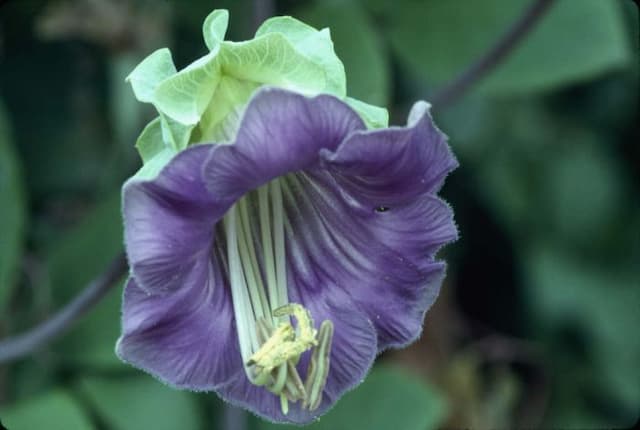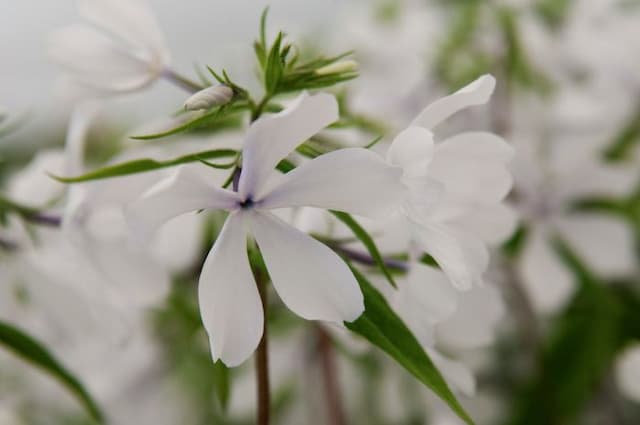Moss Phlox Phlox subulata 'McDaniel's Cushion'

ABOUT
The 'McDaniel's Cushion' is a variety of the widely known moss phlox, showing off a dense, ground-hugging habit. The plant is recognized for its needle-like leaves which create a fine-textured, lush mat of evergreen foliage, presenting a soft appearance overall. During the blooming period, 'McDaniel's Cushion' becomes adorned with a profusion of vibrant, eye-catching flowers. These blooms are typically a rich pinkish-purple in color, which can create a stunning carpet-like effect when seen in mass plantings. The vivid blossoms are tubular with five rounded petals that spread open and are often spotted with a lighter center or darker eye. The overall impression of 'McDaniel's Cushion' in bloom is that of a vivid, colorful cushion, bringing life and beauty to the landscapes and gardens where they are grown.
About this plant
 Names
NamesFamily
Polemoniaceae
Synonyms
Creeping Phlox, Moss Phlox, Moss Pink, Mountain Phlox, Ground Pink, Ground Phlox, Moss Pinks
Common names
Phlox subulata 'McDaniel's Cushion'
 Toxicity
ToxicityTo humans
Moss Phlox is generally considered non-toxic to humans. Therefore, ingesting it is unlikely to cause poisoning or harmful symptoms. However, as with any plant material, individual allergies or sensitivities could provoke a reaction in some people.
To pets
Moss Phlox is also not known to be toxic to pets. It should not cause any symptoms of poisoning if a pet were to ingest the plant. However, it's always best to monitor pets around plants and discourage them from eating plant material, as it could potentially cause gastrointestinal upset simply due to the ingestion of non-food items.
 Characteristics
CharacteristicsLife cycle
Perennials
Foliage type
Evergreen
Color of leaves
Green
Flower color
Pink
Height
6 inches (15 cm)
Spread
2 feet (60 cm)
Plant type
Herb
Hardiness zones
3
Native area
North America
Benefits
 General Benefits
General Benefits- Drought Tolerance: Phlox subulata 'McDaniel's Cushion' is well-suited to dry conditions and requires minimal watering once established.
- Low Maintenance: This variety of creeping phlox does not require frequent care beyond occasional watering and trimming to keep it looking tidy.
- Garden Aesthetics: With its vibrant flowers and dense foliage, it adds color and texture to gardens.
- Erosion Control: The mat-forming habit stabilizes soil and prevents erosion on slopes and banks.
- Attracts Pollinators: The blossoms attract bees, butterflies, and other beneficial insects, aiding in the pollination of nearby plants.
- Ground Cover: It effectively covers the ground, reducing weed growth and the need for mulching.
- Seasonal Interest: Phlox subulata 'McDaniel's Cushion' has a long blooming period from spring to early summer, providing extended seasonal interest.
- Adaptability: It can thrive in a range of soil types, from sandy conditions to clay.
- Compact Growth: Its compact size makes it suitable for rock gardens, borders, and small spaces.
- Hardiness: It is cold-tolerant, making it a reliable perennial in many climates.
 Medical Properties
Medical PropertiesThis plant is not used for medical purposes.
 Air-purifying Qualities
Air-purifying QualitiesThis plant is not specifically known for air purifying qualities.
 Other Uses
Other Uses- Creeping Phlox can be used to stabilize soil and prevent erosion on slopes due to its mat-forming growth habit.
- The dense foliage of Creeping Phlox provides a habitat for ground-nesting bees and other beneficial insects.
- This plant can be used in crafting to create natural dyes for fabrics, as the flowers can provide shades of pink and purple.
- As a model organism in botanical studies, Creeping Phlox helps in understanding the genetics of flower development due to its distinct flowering patterns.
- It can be utilized in sensory gardens for its texture and vibrant spring colors, offering a visual and tactile experience.
- The plant is used in fairy gardens for its miniature, moss-like appearance, creating an enchanted landscape aesthetic.
- Creeping Phlox's trailing habit makes it suitable for growing in living walls or vertical gardens to add depth and color.
- It is used in lunar gardens designed to be enjoyed at night, as its bright flowers can reflect moonlight and create a glowing effect.
- Creeping Phlox can serve as an educational tool in schools to demonstrate ground cover growth and lifecycle of perennial plants.
- The durable nature of Creeping Phlox makes it an excellent choice for xeriscaping, requiring minimal water once established.
Interesting Facts
 Feng Shui
Feng ShuiThe Creeping Phlox is not used in Feng Shui practice.
 Plant Symbolism
Plant Symbolism- Harmony: Phlox subulata often grows in clusters with blooms that cover the plant, symbolizing a sense of togetherness and harmony.
- Unity: The dense, cushion-like growth habit of 'McDaniel's Cushion' suggests unity and a tight-knit community.
- New Beginnings: As a perennial that bursts into bloom after a cold winter, it's seen as a representation of fresh starts and new opportunities.
- Agreement: Due to the plant's characteristic of uniform flowering, it's often symbolic of consensus and mutual understanding.
- Calmness: The soft, cushiony appearance of the plant relates to feelings of calmness and comfort.
 Water
WaterCreeping Phlox typically requires moderate watering. You should water this plant deeply enough that the soil becomes moist but not soggy, usually about one inch of water per week, depending on climate and soil conditions. During hot spells or drought, increase watering frequency to keep the soil from drying out completely. For established plants, provide about one gallon per square yard every week if there is no significant rainfall. Always water at the base of the plant to avoid wetting the foliage, which could lead to disease issues.
 Light
LightCreeping Phlox thrives in full sun but can tolerate very light shade. Ideal spots are those that receive at least six hours of direct sunlight each day. Avoid deeply shaded areas, as this can affect the plant's blooming and overall health.
 Temperature
TemperatureCreeping Phlox is a hardy plant that can tolerate a wide temperature range. It can survive minimum winter temperatures down to about -20 degrees Fahrenheit and prefers the growing season temperatures to be within 60 to 85 degrees Fahrenheit. However, it can withstand summer temperatures that climb well above the ideal range as long as it is well-watered.
 Pruning
PruningPruning Creeping Phlox after the blooming period helps to maintain its shape and promote denser foliage. It is often beneficial to lightly trim back the foliage to stimulate new growth and to prevent the center of the plant from becoming bare. Perform this light pruning annually, immediately after the flowers fade in late spring.
 Cleaning
CleaningAs needed
 Soil
SoilCreeping Phlox thrives best in well-draining soil, rich in organic matter with a slightly acidic to neutral pH of 6.0 to 7.0. A soil mix composed of garden soil, compost, and a handful of perlite or coarse sand is ideal to ensure proper drainage and fertility.
 Repotting
RepottingCreeping Phlox, being a hardy ground cover, doesn't require frequent repotting. It should only be repotted or divided every few years if it outgrows its space or to rejuvenate an overcrowded plant.
 Humidity & Misting
Humidity & MistingCreeping Phlox is adaptable and doesn't require high humidity; it thrives in average outdoor humidity levels, making it a low-maintenance plant in terms of humidity requirements.
 Suitable locations
Suitable locationsIndoor
Provide bright light, ensure good air flow for Creeping Phlox.
Outdoor
Plant in sunny spot with well-draining soil for Creeping Phlox.
Hardiness zone
3-9 USDA
 Life cycle
Life cyclePhlox subulata 'McDaniel's Cushion', commonly known as creeping phlox or moss phlox, begins its life cycle as a seed, which germinates in favorable conditions of warm temperatures and moist soil. The seedling emerges and develops into a young plant, establishing a root system and vegetative growth characterized by its needle-like leaves. As the plant matures, it spreads outwards, forming a dense, ground-hugging mat that can be used effectively as a ground cover. The growth continues until the plant reaches maturity, typically in the second year, when it produces vibrant flowers in hues of pink or purple in the spring season, attracting pollinators such as bees and butterflies. After flowering, the plant sets seed, which completes the reproductive cycle. Creeping phlox is a perennial, so it will enter a period of dormancy in the winter months, reducing above-ground activity, but will re-emerge and grow again the following spring.
 Propogation
PropogationPropogation time
Spring-Early Summer
The best time to propagate Phlox subulata, commonly known as Moss Phlox or 'McDaniel's Cushion', is in the spring or early fall. The most popular method of propagation for this plant is through division. To propagate by division, gently lift the plant from the ground and separate the clumps into smaller sections, ensuring that each section has a good portion of roots attached. Replant these divisions immediately into well-draining soil, spacing them about 15 to 18 inches (approximately 38 to 46 centimeters) apart to allow for spreading. Water the newly planted divisions thoroughly. This method is effective for both rejuvenating older plants that may have become woody in the center and for creating more plants to expand your garden or share with others.









